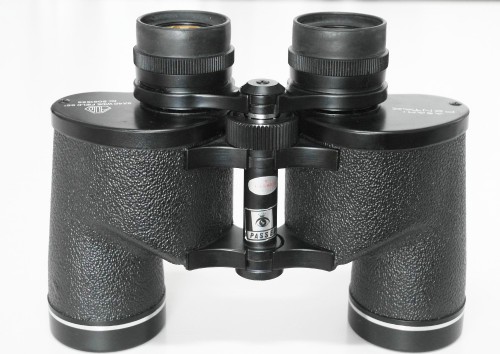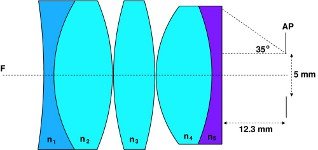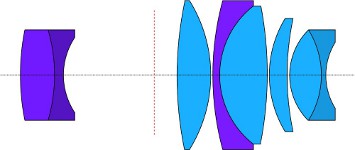by Holger Merlitz
"The binocular market is offering everything that could
possibly sell. If there would exist any additional niche, promising enough
to make money with, then the manufacturers would have already jumped
on it"
This is the standard counter-argument one is facing when suggesting
a new product. Since we have a free market,
everything that possibly makes money already exists and hence there
is no need for any suggestions. That sounds odd, and in fact, concerning
the present binocular market, it is.

8x40 wideangle of ancient times, by Pentax: Fun to use, but
far from being high-end
Many binocular users are aware of the absence of true wideangle
instruments in the high-end sector. While, during the 1960s and
1970s, there were plenty of super-wideangle binoculars made in
Japan and sold all over the world, those had never been of
premium quality and by now they have essentially disappeared from
the store's shelves. Premium wideangle binoculars were made during
short periods in the 1950s and 1960s, by Leitz, and then quickly
disappeared from the high end market. Why is that so? The main
reasons are:
- The manufacturers increasingly focused on the requirements
of the birder as a customer: The birder does not, in general,
require super-wide views, but focuses on a particular subject
near the center of field. It is the observation of details,
rather than surveillance or the inspection of a scenery in
its whole which is the birder's task.
- Wide angles are tough: Optical aberrations increase
rapidly with the angle of view, and even a sophisticated design
leaves a lot for the amateur optics tester to pick at and
complain about ("poor edge-sharpness!") on the Internet discussion
boards - something no high-end manufacturer likes to read about
his product.
- Wide angles are heavy: Prism-size, eyepiece-size - everything
turns XXL, and during times in which small and slim is "sexy",
every marketing expert may be having nightmares when considering
the task of selling 1kg bricks of glass and metal to his
customers.
Yet, there exist good arguments in favor of a new and high quality
wideangle binocular. These are
- Our eyes are wideangle instruments - it is natural to leave
as much of that as possible during visual observation through a
binocular. It makes the fundamental difference between watching
an event trough an instrument or becoming an integrated part
of that event.
- Binocular observation is much more than just observing details
near the center of field. Astronomers enjoy sweeping through the
Milky-Way with wideangle instruments, travelers like to pan over
landscapes at scenic spots, geologists like to study geological
formations in their environmental context.
- Most significantly: We now have reached a technological
level that allows us to combine wide fields of view with
high image quality and comfort of view.
In what follows I want to focus on the last point. One has to
bear in mind that during the 1960s and 1970s, toward the end of the "golden
age of wideangle binocular construction" as stated by Fan Tao,
the technology of eyepiece design was still on the level
of the 1920s, with variations of the Erfle-design all over the
place and nothing much else. Those were fine up to apparent angles
of view about 65 degs, and were certainly overstretched when applied to angles beyond
70 degs. Additionally, those eyepieces had a poor eye-relief,
hence were impossible to be used with glasses and still inconvenient
without.


Left: Modified Erfle eyepiece. Right: Nagler eyepiece (US patent 4747675, 1988)
With the dramatic improvements in eyepiece design, triggered by
the Naglers during the 1980s and thereafter, the situation
has changed entirely. The construction of a high quality eyepiece
with 75 degs field, which remains sufficiently compact to be
used in a binocular, and which offers a reasonable eye-relief for
viewing comfort, has become possible. Those oculars contain
field-flattener ("Smyth-") lenses that significantly increase eye-relief, and at the same time reduce field-curvature and improve edge-sharpness.
Another significant improvement since the 1980s
was the development of low-dispersion ("ED"-) glasses that
revolutionized the objective designs of premium binoculars.
Nowadays, ED triplets are capable of delivering image
qualities far off the center of field that were unheard of
a couple of decades ago.
Finally, coating technology has advanced a lot in recent years, allowing for a wider range of optical designs without excessive loss of transmission or the danger of emerging stray light.
So, what then would be a reasonable proposal for a modern
wide-angle binocular? My suggestion is
an 8x40 binocular with 75 degs. apparent angle of field
and eye-relief of 16mm. Why would I suggest that, and how
did I come to these numbers? The answers are:
- 8x40 is the ideal all-purpose format, with 5mm exit pupil being
suitable for a wide range of applications, with 8x comfortably
hand held, and with 40mm lenses small enough to enable the
implementation of very wide angles without turning excessively heavy.
- 16mm eye-relief allows for a comfortable view and at the
same time delivers a manageable eyepiece size. The eyepiece-lens
that faces the eye will have a diameter of just below 30mm,
and there remains space for the nose in between both oculars.
- The instrument, if made with Porro prisms, would have
a weight of roughly 1kg and would probably cost between
1000 and 1500 Euro if made in Japan. Remind, for comparison,
the 10x50 Fujinon FMTR-SX which has 65 degs. field,
oculars with field flattener and high edge-sharpness,
with a price-tag about 750 US$.
- If made as a roof prism binocular, such an instrument would
possibly weight roughly 850g, but its price would reach
or exceed that of existing premium roof binoculars.
- Even hybrid prism-mirror designs as employed before
with the
Leitz Amplivid of the 1960s are now thinkable. Leitz abandoned that
design, also because the mirrors of those days, made of aluminum,
easily lost their reflectivity. Today's dielectric mirrors have
a reflectivity near 100% and come with unlimited lifetime.
In the past, there have been super-wideangle binoculars of
the 8x40 format, for example the
Zeiss Deltarem
and the Huet roof
binoculars, both with almost 90 degs. fields. However, these designs
were surely overstretched, with very poor edge-sharpness and,
necessarily, short eye-relief (the eyepiece diameter scales proportional
with the eye-relief and the tangent of the apparent half-angle of view).
Stopped down to 75 degs., combined with present time technology,
such a design would now become manageable, including high image quality
and viewing comfort.
Back Home
Last modified: Jan 2012

